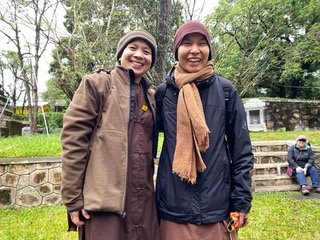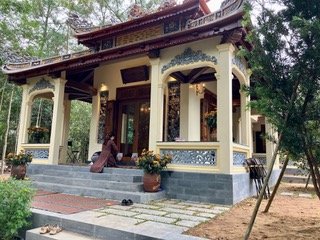Monday, November 4, we will meet in person.
Go to calendar for our schedule
Address for OHMC meditation space:
3812 Northampton St. NW, Washington DC 20015
Please arrive a few minutes early so we can invite the bell on time. You may also arrive 15 minutes early to practice working meditation by helping us set up cushions.
New to sangha?
This Monday we are offering an optional Newcomers Orientation.
Learn more and sign up here
Dear friends,
This week, we will meet Monday evening, Nov. 4, from 7-8:30PM EST in person at our meditation space (3812 Northampton Street NW); Wednesday morning, Nov. 6, from 7-8AM EST online; and Friday, Nov. 8, from 12-1PM EST in person.
This Monday evening, Magda will facilitate. Magda shares:
In the first part of this write-up, I reflected on my visit to Tú Hiéu Monastery in Vietnam, where I participated in ceremonies honoring Thich Nhat Hanh as an ancestral teacher. The event began with a long chanting ritual, during which offerings were made, highlighting Thay's humility as one among many beings. I connected this experience to the Buddhist idea of dedicating merit to all beings, recalling my earlier skepticism about this inclusive perspective. Drawing from Taoist, Confucian, and Jain teachings, I explored the idea of universal interconnectedness through the concepts of Qi, the Tao, and Ahimsa, all of which emphasize empathy and the unity of life.
I also contemplated the Buddhist teaching of Anatta, the doctrine that the self is an illusion, envisioning my spiritual path as concentric circles moving away from the ego and toward oneness with all beings. This insight deepened during my visit, where the natural environment of Thay’s sanctuary became a spiritual guide. The Qi connecting all things brought me a profound sense of peace and belonging, culminating in my deep connection with the land and the elements around me, symbolized by my taking of a pinecone as a memento of the sanctuary's timeless energy.
In the following sections, I will continue to express my insights about the sense of interbeing I felt with humanity and Thay while at Tu Hieu. As you read my reflections, I invite you to consider your own experiences of interbeing with the Earth, with humanity, and with Thay, as well as other spiritual teachers or ancestors.
My painting of Tu Hieu reflects much of what I learned at the monastery, drawing from my experiences, the insights shared by Sister Dinh Nghiem and other monastics, and Thay's writings in My Master’s Robe: Memories of a Novice Monk about Tu Hieu.
ONE WITH HUMANITY
At the testimonial ceremony for Thay in Tu Hieu, Brother Phap Huu summarized the night’s message: “Thay never asked me to be a perfect person. He made me feel I am enough.” Once, when he was trying to protect Thay from the crowds, Thay touched his head and told him, “You and I are the same.” Brother Phap Huu finished his testimony by saying “Thank you for being in me and in the sangha.”
Though Thay was a brilliant and charismatic leader, he exemplified humility. His ultimate demonstration of humility was his request to have the portion of his ashes left at Tu Hieu deposited where his hut once stood, as if he did not want to take space from the rest of the 10,000 beings.
I felt a kind of timeless connection with Thay’s spiritual ancestors. One was the monk whose devotion to his mother inspired a king to name this monastery The Monastery of Filial Piety. Another was Thay’s revered teacher, who saw Thay’s enormous promise and spent a whole night sewing his first brown robe. I also felt connected to some of the brothers and sisters Thay wrote about in My Master’s Robe: Brother Dung whose real vocation was to invite the bell; Brother Than Man who brought delicious golden potatoes to Thay; and the wise cook Auntie Tu.
I also felt deeply connected with those who were physically present with me at Tu Hieu: the Vietnamese man who quietly took my broom to accumulate merit; and the Vietnamese women who picked up leaves with their bare hands to assist me; the many monastics, especially Sister Ðhin Nghiém and Sister Tue Nghiém, who organized the journey so peacefully; and all the laypeople who, like me, consider Thay their most important teacher. As hundreds of us gathered to have lunch after the ceremonies, I had the thought that Thay would have been happy. He had managed to foster interbeing between people from all walks of life. The Great Bell was heard in the East and the West. In an ageless way, we were all one.
ONE WITH THAY
At Tu Hieu I saw Thay as a vulnerable human being like me. Brother Phap Huu recounted how Thay once told him, “I give you permission to suffer.” I thought of those words as I looked upon Thay’s shrine in the Master’s Courtyard. In front of the shrine stood two starfruit trees, well known to Thay’s disciples: one bitter and one sweet. “ Yes, Thay,” I thought. “Your life and mine have indeed been filled with the bitter and the sweet.” I sat in meditation sending him my energy of gratitude for how he has healed me.
At Tu Hieu, I envisioned Thay in all of his life cycles. I saw him as an innocent 16-year-old boy full of vitality, entering through the three-door gate with his older brother’s arm around him. I saw him shivering in the early mornings before spending much of the day tending cattle and collecting leaves and shrubs. I saw him studying The Essential Vinaya for Daily Use, and teaching Chinese to Auntie Tu. I saw him hiding in the forest when the monastery was no longer safe and deciding to invite the Great Bell on the night of Tet, despite the high risk. I saw him joyful at the sight of thousands of lights flashing in the night. I saw him learning the practices of mindfulness and meditation that he would share with the world.
I saw Thay touching the door again, filled with joy when he returned after 39 years in exile. And I saw him returning in a wheelchair for his final stay. I stood in front of his hut, where his ashes lay, and I saw what he saw. I said, “I have arrived, I am home.”
RITUALS AND ONENESS
“Living beings are countless but I vow to help them all.”
-words written by Thay on one of the columns of the monastery
Like Taoism, Confucianism, and Jainism, Thay’s Engaged Buddhism teaches us that all creatures are equally valuable and that we are intricately connected; that separateness and duality are illusions. This ethic of interbeing is reflected in the Five Mindfulness Trainings. It is also reflected in the more detailed Fourteen Mindfulness Trainings that around 3,000 Order of Interbeing members from all over the world have received. It seems to me that this ethic is more important today than ever.
I was brought up to believe in the superiority of the human race., but the Buddhist teachings of Anatta, Nonduality, and Interbeing, teachings that I have come to appreciate even more with my pilgrimage, have added concentric circles to my spiritual map. My path continues to take me further away from my ego, towards the understanding that all beings matter.
In my youth, I also participated in religious rituals that emphasized the illusions of separation, duality, superiority and inferiority. At Tu Hieu, however, I was part of a ritual that had real ethical meaning, a ritual that transformed me.
Questions for Exploration:
1) Describe when you have felt as one with humanity.
2) Describe when you have felt as one with Thay and/or other spiritual teachers or ancestors.
3) Describe when you have felt as one with the cosmos.








